2007 GMC SIERRA CLASSIC wheel size
[x] Cancel search: wheel sizePage 449 of 674

Weight-Distributing Hitches and Weight
Carrying Hitches
A:Body to Ground Distance
B:Front of Vehicle
When using a weight-distributing hitch, the hitch
must be adjusted so the distance (A) remains
the same both before and after coupling the trailer
to the tow vehicle.If you use a step-bumper hitch, the bumper could
be damaged in sharp turns. Make sure there is
ample room when turning to avoid contact between
the trailer and the bumper.
If you will be pulling a trailer that, when loaded,
will weigh more than 5,000 lbs (2 270 kg) be sure
to use a properly mounted weight-distributing
hitch and sway control of the proper size.
This equipment is very important for proper vehicle
loading and good handling when driving. Always
use a sway control if the trailer will weigh
more than these limits. You can ask a hitch dealer
about sway controls.
Fifth Wheel and Gooseneck Trailering
Fifth wheel and gooseneck trailers can be
used with many pickup models. These trailers
place a larger percentage of the weight (kingpin
weight) on the tow vehicle than conventional
trailers. Make sure this weight does not cause the
vehicle to exceed GAWR or GVWR.
Fifth wheel or gooseneck kingpin weight should be
15 to 25 percent of the trailer weight up to the
maximum amount speci�ed in the trailering chart
for your vehicle. See “Weight of the Trailer” in
this section for more information.
449
Page 466 of 674
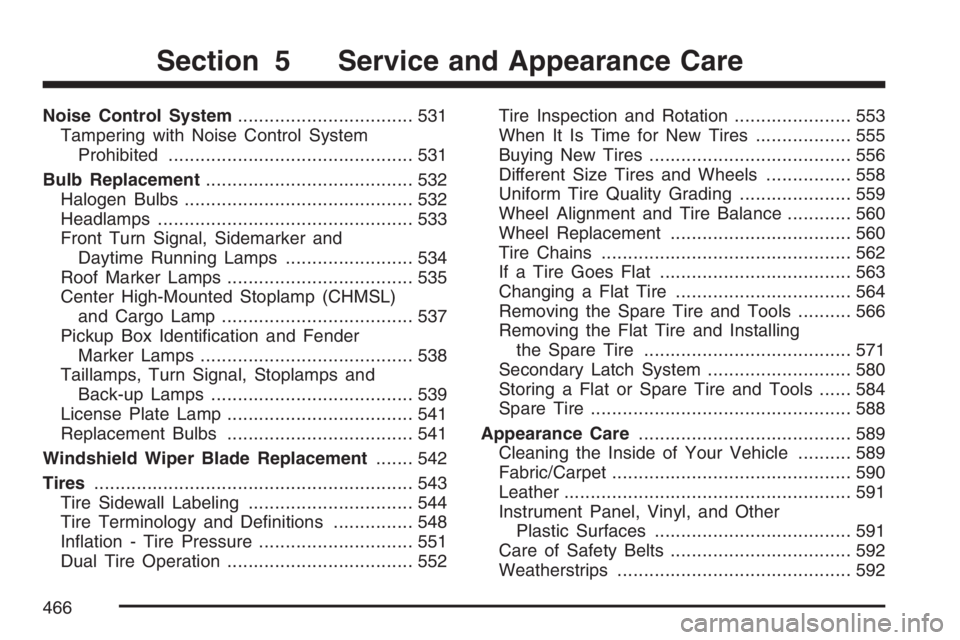
Noise Control System................................. 531
Tampering with Noise Control System
Prohibited.............................................. 531
Bulb Replacement....................................... 532
Halogen Bulbs........................................... 532
Headlamps................................................ 533
Front Turn Signal, Sidemarker and
Daytime Running Lamps........................ 534
Roof Marker Lamps................................... 535
Center High-Mounted Stoplamp (CHMSL)
and Cargo Lamp.................................... 537
Pickup Box Identi�cation and Fender
Marker Lamps........................................ 538
Taillamps, Turn Signal, Stoplamps and
Back-up Lamps...................................... 539
License Plate Lamp................................... 541
Replacement Bulbs................................... 541
Windshield Wiper Blade Replacement....... 542
Tires............................................................ 543
Tire Sidewall Labeling............................... 544
Tire Terminology and De�nitions............... 548
In�ation - Tire Pressure............................. 551
Dual Tire Operation................................... 552Tire Inspection and Rotation...................... 553
When It Is Time for New Tires.................. 555
Buying New Tires...................................... 556
Different Size Tires and Wheels................ 558
Uniform Tire Quality Grading..................... 559
Wheel Alignment and Tire Balance............ 560
Wheel Replacement.................................. 560
Tire Chains............................................... 562
If a Tire Goes Flat.................................... 563
Changing a Flat Tire................................. 564
Removing the Spare Tire and Tools.......... 566
Removing the Flat Tire and Installing
the Spare Tire....................................... 571
Secondary Latch System........................... 580
Storing a Flat or Spare Tire and Tools...... 584
Spare Tire................................................. 588
Appearance Care........................................ 589
Cleaning the Inside of Your Vehicle.......... 589
Fabric/Carpet............................................. 590
Leather...................................................... 591
Instrument Panel, Vinyl, and Other
Plastic Surfaces..................................... 591
Care of Safety Belts.................................. 592
Weatherstrips............................................ 592
Section 5 Service and Appearance Care
466
Page 548 of 674
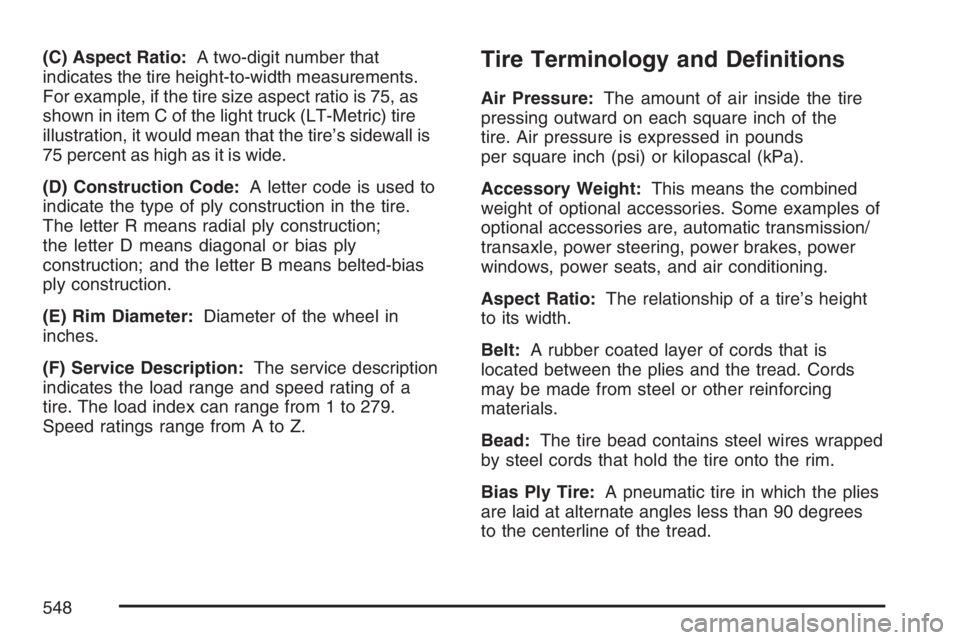
(C) Aspect Ratio:A two-digit number that
indicates the tire height-to-width measurements.
For example, if the tire size aspect ratio is 75, as
shown in item C of the light truck (LT-Metric) tire
illustration, it would mean that the tire’s sidewall is
75 percent as high as it is wide.
(D) Construction Code:A letter code is used to
indicate the type of ply construction in the tire.
The letter R means radial ply construction;
the letter D means diagonal or bias ply
construction; and the letter B means belted-bias
ply construction.
(E) Rim Diameter:Diameter of the wheel in
inches.
(F) Service Description:The service description
indicates the load range and speed rating of a
tire. The load index can range from 1 to 279.
Speed ratings range from A to Z.Tire Terminology and De�nitions
Air Pressure:The amount of air inside the tire
pressing outward on each square inch of the
tire. Air pressure is expressed in pounds
per square inch (psi) or kilopascal (kPa).
Accessory Weight:This means the combined
weight of optional accessories. Some examples of
optional accessories are, automatic transmission/
transaxle, power steering, power brakes, power
windows, power seats, and air conditioning.
Aspect Ratio:The relationship of a tire’s height
to its width.
Belt:A rubber coated layer of cords that is
located between the plies and the tread. Cords
may be made from steel or other reinforcing
materials.
Bead:The tire bead contains steel wires wrapped
by steel cords that hold the tire onto the rim.
Bias Ply Tire:A pneumatic tire in which the plies
are laid at alternate angles less than 90 degrees
to the centerline of the tread.
548
Page 557 of 674

{CAUTION:
Mixing tires could cause you to lose
control while driving. If you mix tires of
different sizes, brands, or types (radial
and bias-belted tires), the vehicle may not
handle properly, and you could have a
crash. Using tires of different sizes,
brands or types may also cause damage
to your vehicle. Be sure to use the same
size, brand, and type tires on all wheels.
Your vehicle may have a different size
spare than the road tires (those originally
installed on your vehicle). When new, your
vehicle included a spare tire and wheel
assembly with a similar overall diameter
as your vehicle’s road tires and wheels,
so it is all right to drive on it. Because
this spare was developed for use on your
vehicle, it will not affect vehicle handling.
{CAUTION:
If you use bias-ply tires on your vehicle,
the wheel rim �anges could develop
cracks after many miles of driving. A tire
and/or wheel could fail suddenly, causing
a crash. Use only radial-ply tires with the
wheels on your vehicle.
If you must replace your vehicle’s tires with those
that do not have a TPC Spec number, make
sure they are the same size, load range, speed
rating, and construction type (radial and
bias-belted tires) as your vehicle’s original tires.
Your vehicle’s original equipment tires are listed
on the Tire and Loading Information Label.
This label is attached to the vehicle’s center pillar
(B-pillar). SeeLoading Your Vehicle on page 409,
for more information about the Tire and Loading
Information Label and its location on your vehicle.
557
Page 558 of 674
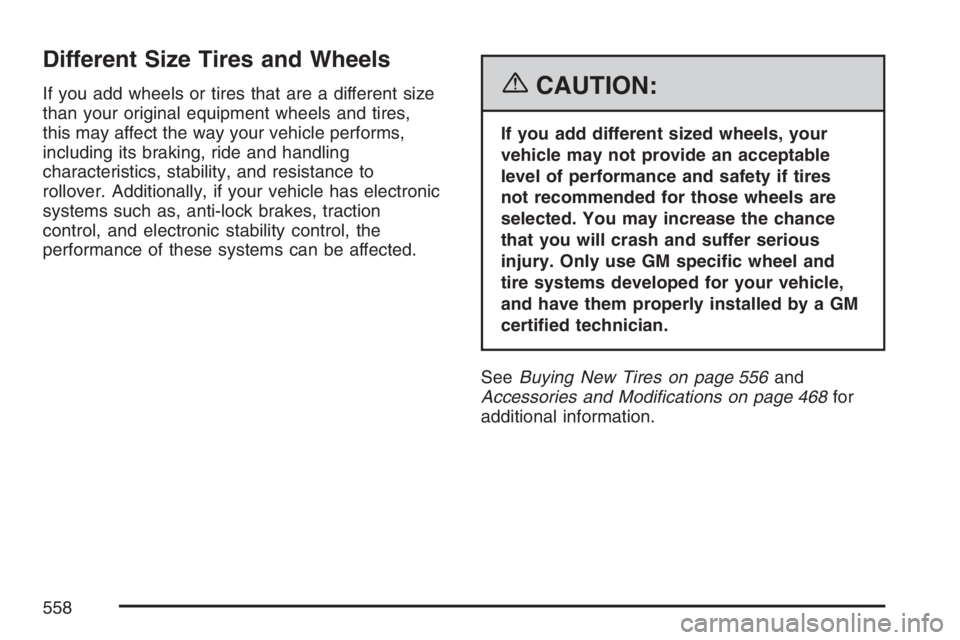
Different Size Tires and Wheels
If you add wheels or tires that are a different size
than your original equipment wheels and tires,
this may affect the way your vehicle performs,
including its braking, ride and handling
characteristics, stability, and resistance to
rollover. Additionally, if your vehicle has electronic
systems such as, anti-lock brakes, traction
control, and electronic stability control, the
performance of these systems can be affected.{CAUTION:
If you add different sized wheels, your
vehicle may not provide an acceptable
level of performance and safety if tires
not recommended for those wheels are
selected. You may increase the chance
that you will crash and suffer serious
injury. Only use GM speci�c wheel and
tire systems developed for your vehicle,
and have them properly installed by a GM
certi�ed technician.
SeeBuying New Tires on page 556and
Accessories and Modi�cations on page 468for
additional information.
558
Page 562 of 674
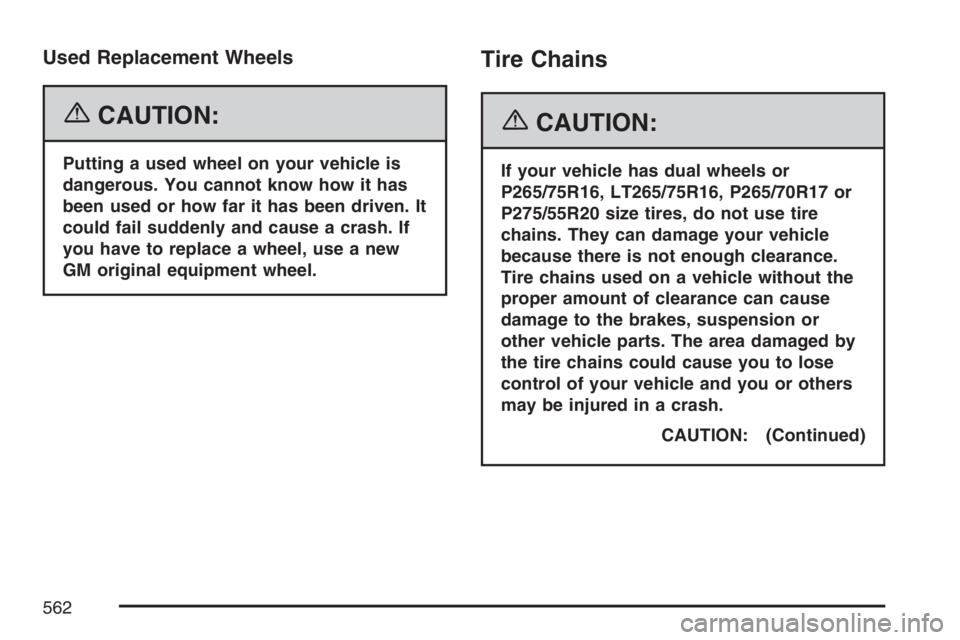
Used Replacement Wheels
{CAUTION:
Putting a used wheel on your vehicle is
dangerous. You cannot know how it has
been used or how far it has been driven. It
could fail suddenly and cause a crash. If
you have to replace a wheel, use a new
GM original equipment wheel.
Tire Chains
{CAUTION:
If your vehicle has dual wheels or
P265/75R16, LT265/75R16, P265/70R17 or
P275/55R20 size tires, do not use tire
chains. They can damage your vehicle
because there is not enough clearance.
Tire chains used on a vehicle without the
proper amount of clearance can cause
damage to the brakes, suspension or
other vehicle parts. The area damaged by
the tire chains could cause you to lose
control of your vehicle and you or others
may be injured in a crash.
CAUTION: (Continued)
562
Page 563 of 674
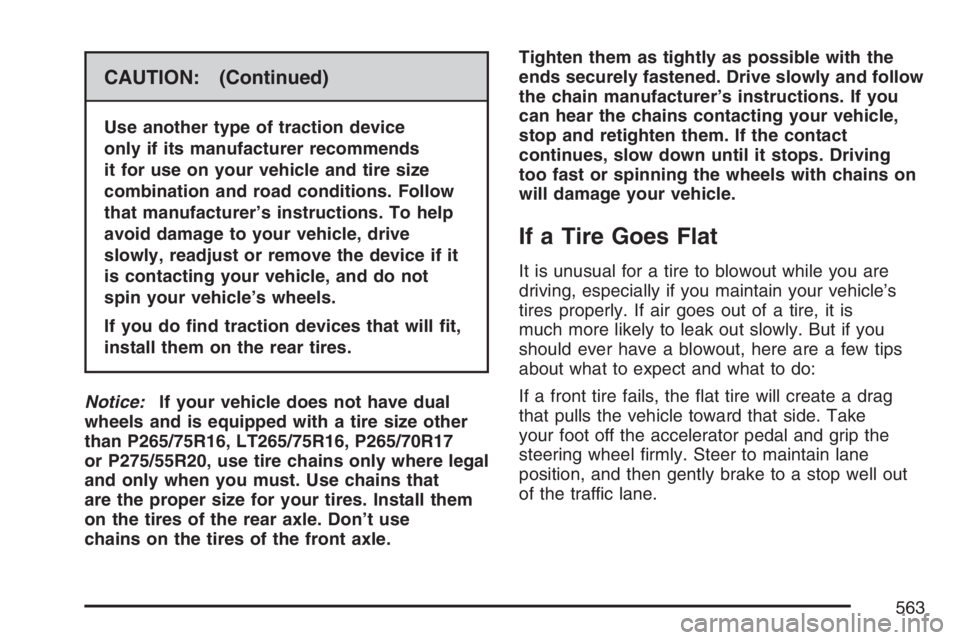
CAUTION: (Continued)
Use another type of traction device
only if its manufacturer recommends
it for use on your vehicle and tire size
combination and road conditions. Follow
that manufacturer’s instructions. To help
avoid damage to your vehicle, drive
slowly, readjust or remove the device if it
is contacting your vehicle, and do not
spin your vehicle’s wheels.
If you do �nd traction devices that will �t,
install them on the rear tires.
Notice:If your vehicle does not have dual
wheels and is equipped with a tire size other
than P265/75R16, LT265/75R16, P265/70R17
or P275/55R20, use tire chains only where legal
and only when you must. Use chains that
are the proper size for your tires. Install them
on the tires of the rear axle. Don’t use
chains on the tires of the front axle.Tighten them as tightly as possible with the
ends securely fastened. Drive slowly and follow
the chain manufacturer’s instructions. If you
can hear the chains contacting your vehicle,
stop and retighten them. If the contact
continues, slow down until it stops. Driving
too fast or spinning the wheels with chains on
will damage your vehicle.
If a Tire Goes Flat
It is unusual for a tire to blowout while you are
driving, especially if you maintain your vehicle’s
tires properly. If air goes out of a tire, it is
much more likely to leak out slowly. But if you
should ever have a blowout, here are a few tips
about what to expect and what to do:
If a front tire fails, the �at tire will create a drag
that pulls the vehicle toward that side. Take
your foot off the accelerator pedal and grip the
steering wheel �rmly. Steer to maintain lane
position, and then gently brake to a stop well out
of the traffic lane.
563
Page 588 of 674
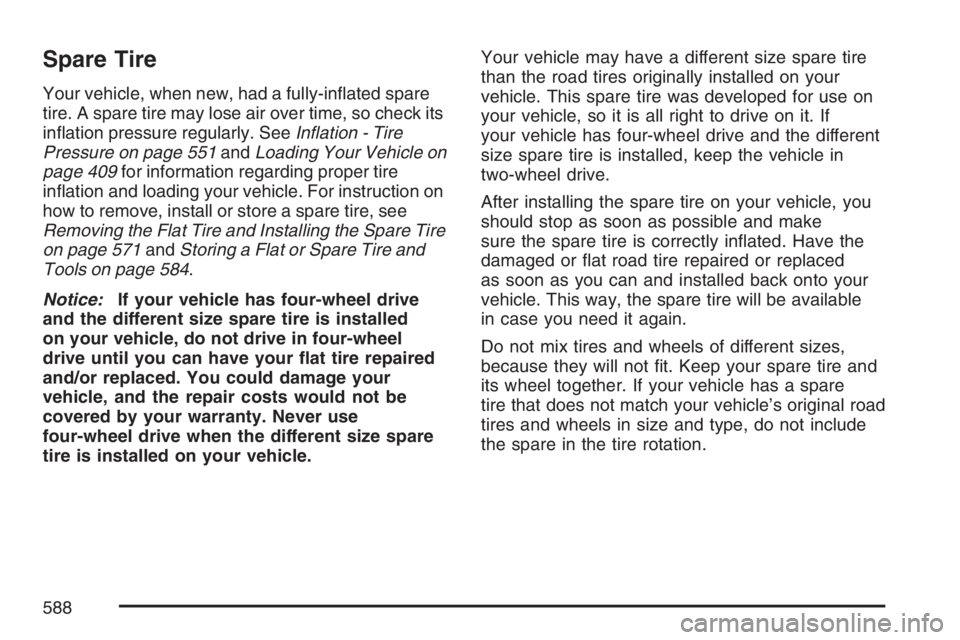
Spare Tire
Your vehicle, when new, had a fully-in�ated spare
tire. A spare tire may lose air over time, so check its
in�ation pressure regularly. SeeIn�ation - Tire
Pressure on page 551andLoading Your Vehicle on
page 409for information regarding proper tire
in�ation and loading your vehicle. For instruction on
how to remove, install or store a spare tire, see
Removing the Flat Tire and Installing the Spare Tire
on page 571andStoring a Flat or Spare Tire and
Tools on page 584.
Notice:If your vehicle has four-wheel drive
and the different size spare tire is installed
on your vehicle, do not drive in four-wheel
drive until you can have your �at tire repaired
and/or replaced. You could damage your
vehicle, and the repair costs would not be
covered by your warranty. Never use
four-wheel drive when the different size spare
tire is installed on your vehicle.Your vehicle may have a different size spare tire
than the road tires originally installed on your
vehicle. This spare tire was developed for use on
your vehicle, so it is all right to drive on it. If
your vehicle has four-wheel drive and the different
size spare tire is installed, keep the vehicle in
two-wheel drive.
After installing the spare tire on your vehicle, you
should stop as soon as possible and make
sure the spare tire is correctly in�ated. Have the
damaged or �at road tire repaired or replaced
as soon as you can and installed back onto your
vehicle. This way, the spare tire will be available
in case you need it again.
Do not mix tires and wheels of different sizes,
because they will not �t. Keep your spare tire and
its wheel together. If your vehicle has a spare
tire that does not match your vehicle’s original road
tires and wheels in size and type, do not include
the spare in the tire rotation.
588